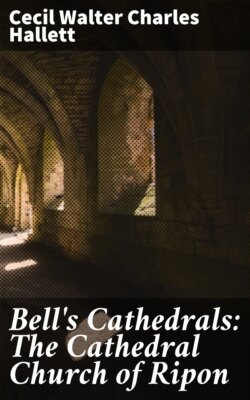Bell's Cathedrals: The Cathedral Church of Ripon

Реклама. ООО «ЛитРес», ИНН: 7719571260.
Оглавление
Cecil Walter Charles Hallett. Bell's Cathedrals: The Cathedral Church of Ripon
Bell's Cathedrals: The Cathedral Church of Ripon
Table of Contents
PREFACE
CHAPTER I. HISTORY OF THE CHURCH
CHAPTER II. THE EXTERIOR
CHAPTER III. THE INTERIOR
CHAPTER IV. OTHER OLD BUILDINGS IN RIPON
APPENDIX
INDEX
Отрывок из книги
Cecil Walter Charles Hallett
A Short History of the Church and a Description of Its Fabric
.....
Ripon did not escape the violence of the Danes. It is thought that about the year 860 they burned the town and did some damage to the church, and the remarkable mound known as Ailcy Hill,[9] near the Canons’ Residence, and due east of the Cathedral, is probably a relic of some battle of this period. In the street-names too, all ending in ‘gate’ (which in the sense of ‘way’ is a Danish word), another trace may perhaps be found of their presence, as well as of the existence of a town at this early period. The town probably grew up around the monastery. It has been believed that a civic charter was granted by King Alfred in 886; but this is impossible, even if such charters were ever granted at this time, for Alfred had resigned all this part of England (which since about 839 had owned the overlordship of Wessex) to the Danes in 878.
One of the great events in Ripon history is the visit of Alfred’s grandson King Athelstan. Yorkshire had lately been a separate Danish kingdom, but it passed under the direct rule of Wessex in 926, and it was either in that year that Athelstan came, or in 937, when he defeated the Scots and other northern rebels at Brunanburh. It was to this king that the church afterwards referred the grant of its most important privileges. Among these was that of sanctuary, by which homicides, thieves, debtors, etc., could flee to Ripon and live there under the protection of St. Wilfrid for a specified time. The area within which they were protected extended one mile from the church in every direction, and the limit was marked by eight crosses, the base of one of which is still to be seen on the Sharow Road. The penalties for molesting refugees were afterwards graduated as follows:—between the limit and the graveyard wall, £18; within the graveyard, £36; within the choir (where the pursued sought the last possible refuge at the ‘grythstool,’ or chair of sanctuary), confiscation of goods and possible death. Those who took sanctuary were called ‘gyrthmen’ or ‘grythmen’ (from the Anglo-Saxon ‘gryth’ ‘peace’), and undertook, among other things, to carry the banners before the relics of St. Wilfrid in certain processions. They were under the spiritual charge of a ‘gryth-priest.’ The protection of the outer sanctuary can hardly have been extended to Ripon men, as theoretically the whole town could then have committed crimes with impunity, and practically the criminals would not have been safe from their fellow-townsmen. Ripon debtors did indeed enjoy protection here at Rogation-tide, but as a rule men of Ripon would seek sanctuary at Durham or Beverley. Athelstan is also said to have granted to the church a jurisdiction over its lands independent alike of the northern archbishop and of the king, with the right to inflict the ordeals of fire and water, and with exemption from taking oaths, from taxation, and from military service.[10] Of the two charters in which these grants are set forth, one is, indeed of the eleventh or twelfth, and the other of the thirteenth century, but Athelstan may at any rate have done something to give rise to the tradition, though it is impossible to tell exactly what. The story of his having given the manor to the see of York is doubtless misleading. The territorial sway of the Archbishop at Ripon must be of earlier origin, and it may even have arisen out of the grant of the monastery with its thirty or forty hides of land to Wilfrid and his retention of them after his elevation to the see of Northumbria.
.....